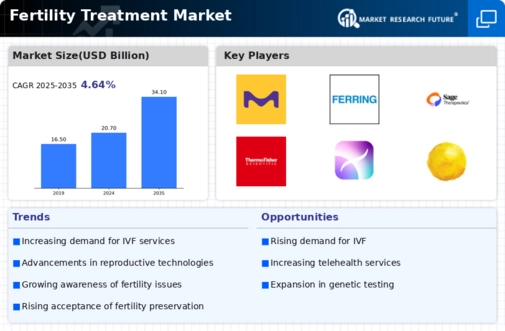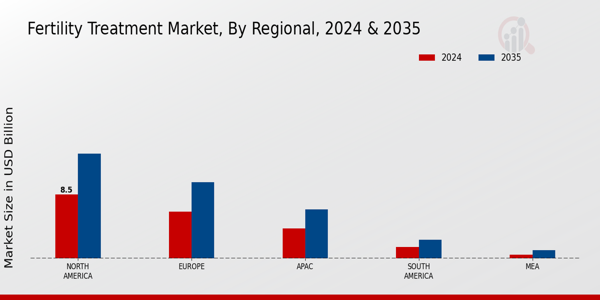Changing Social Norms
Changing social norms regarding family planning and childbearing are reshaping the Global Fertility Treatment Market Industry. As societal attitudes evolve, more individuals are prioritizing career and personal development before starting families. This shift often leads to delayed childbearing, which can increase the likelihood of infertility. Consequently, there is a growing acceptance of fertility treatments as viable options for those wishing to conceive later in life. The market's expansion reflects this trend, as more couples seek assistance in achieving their family goals. The increasing demand for fertility services aligns with the projected market growth to 34.1 USD Billion by 2035.
Rising Infertility Rates
The Global Fertility Treatment Market Industry is witnessing a notable increase in demand due to rising infertility rates across various demographics. Factors such as delayed childbearing, lifestyle changes, and environmental influences contribute to this trend. For instance, the World Health Organization indicates that infertility affects approximately 15% of couples globally. As awareness of fertility issues grows, more individuals seek treatment options, thereby driving market growth. In 2024, the market is projected to reach 20.7 USD Billion, reflecting the urgent need for effective fertility solutions. This trend is expected to continue, with the market expanding significantly in the coming years.
Market Growth Projections
The Global Fertility Treatment Market Industry is poised for substantial growth, with projections indicating a market value of 20.7 USD Billion in 2024 and an anticipated increase to 34.1 USD Billion by 2035. This growth trajectory suggests a robust compound annual growth rate (CAGR) of 4.64% from 2025 to 2035. Such projections are indicative of the increasing demand for fertility treatments driven by various factors, including rising infertility rates, technological advancements, and changing societal norms. The market's expansion reflects a growing recognition of the importance of reproductive health and the need for accessible fertility solutions.
Technological Advancements
Technological innovations play a crucial role in shaping the Global Fertility Treatment Market Industry. Advances in assisted reproductive technologies, such as in vitro fertilization (IVF) and intracytoplasmic sperm injection (ICSI), enhance success rates and patient outcomes. The integration of artificial intelligence and genetic screening further optimizes treatment protocols, allowing for personalized approaches to fertility care. As these technologies become more accessible and affordable, they attract a broader patient base. The market is anticipated to grow at a CAGR of 4.64% from 2025 to 2035, indicating a robust future driven by continuous innovation in fertility treatments.
Government Support and Funding
Government initiatives and funding significantly influence the Global Fertility Treatment Market Industry. Many countries are recognizing the importance of reproductive health and are implementing policies to support fertility treatments. This includes financial assistance for couples undergoing fertility procedures and funding for research into new treatment methods. For example, several European nations have established programs to subsidize IVF treatments, making them more accessible. Such government support not only alleviates the financial burden on patients but also encourages the development of innovative fertility solutions. This supportive environment is expected to propel market growth in the coming years.
Increased Awareness and Education
Awareness and education regarding fertility issues are pivotal in the Global Fertility Treatment Market Industry. Campaigns by health organizations and fertility clinics aim to inform the public about reproductive health and available treatment options. This increased awareness leads to earlier consultations and a higher likelihood of seeking fertility treatments. Educational initiatives also address misconceptions surrounding infertility, thereby reducing stigma. As a result, more individuals are likely to pursue fertility assistance, contributing to market growth. The projected market value of 34.1 USD Billion by 2035 underscores the impact of these awareness campaigns on the industry's expansion.












